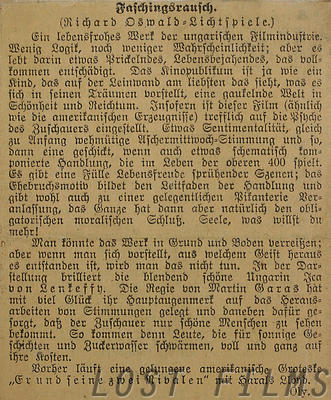|
Farsangi mámor
press document > review
Title
Farsangi mámor (review)
Description
Review of a screening at the Richard-Oswald-Lichtspiele cinema in Berlin, most likely the première on 2nd November 1922. The author, 'Oly', was Fritz Olimsky, a prolific Berlin-based film critic whose personal estate is one of many held by the Deutsche Kinemathek. This copy of the review has survived as a clipping in a scrapbook of Olimsky's writings compiled by the author or his wife. Unfortunately there is no indication of the specific publication in which this review first appeared. As Olimsky had no affiliation with any one publication during his career, and the Gothic-style typeface was used by many publishers during this time, its exact origin is difficult to determine. The date is most likely 5th November 1922, as indicated by the numbers "05.11.22." handwritten next to the clipping in the scrapbook. The Richard-Oswald-Lichtspiele started life as the Prinzeß-Theater in 1911. Located on Kantstraße 163 in Berlin, the 800 capacity converted shop was two full storeys high, with 40 boxes in the upper storey and 560 seats on the ground floor. The theatre was designed by Lucien Bernard (1883-1972), who was a poster painter by trade. In 1919, the Viennese film producer, director and eager entrepreneur Richard Oswald bought the Prinzeß-Theater and reopened it on 19th September as the Richard-Oswald-Lichtspiele. A month later he opened a second cinema in Berlin, this time on Köpenicker Straße 68. By January the following year he had already yielded control of the second cinema to concentrate entirely on running his operation at Kantstraße, which was considered the better asset, being located in the very heart of Berlin's cinema district at that time. Practically every one of Oswald's films produced before 1925, as well as those of other producers, received its première at the Richard-Oswald-Lichtspiele on Kantstraße. From 1925 onwards, Oswald started renting out the cinema to other exhibitors, a change that mirrored the downturn in his fortunes during this time, having faced difficulty in realising certain projects and having suffered the commercial failure of others. In March 1926 his production company, Richard Oswald-Film A.G., formally filed for bankruptcy. Three years later the local magistrate's court in Berlin-Mitte announced that the cinema's business activities had been to all extents and purposes discontinued. Four months later it was officially removed from the German trade register. Oliver Hanley / Gerrit Thies, Deutsche Kinemathek, 06.12.2010 Selected literature (all links still active as of the publication date) * Tim Bentinck, Berlin Cinemas: The development of the cinema in Berlin since 1900, final year thesis for a degree in History of Art at the University of East Anglia, England, June 1975 * Hans-Michael Bock, "Biographie," in Helga Belach, Wolfgang Jacobsen (eds.), Richard Oswald: Regisseur und Produzent, Munich: edition text + kritik, 1990 * Jürgen Kasten, "Expansion, Spekulation und die Freiheit des Produzenten. Zur Wirtschaftsgeschichte von Richard Oswalds Filmfirmen 1916-1925," in Kasten, Armin Loacker (eds.), Richard Oswald; Kino zwischen Spektakel, Aufklärung und Unterhaltung, Vienna: Verlag Filmarchiv Austria, 2005, pp. 433-453
Id number
4.3_89-3_VAR_01a_24
Related collections
Deutsche Kinemathek - Museum für Film und Fernsehen (is a part of)
Collection category
personal estate archive
Classification
press document > review |
 |